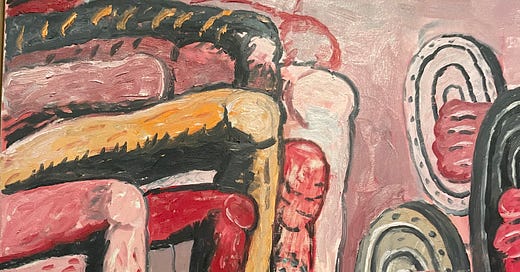Run, if you can, don’t walk to see the Philip Guston show up at the National Gallery in Washington DC. Philip Guston Now, a retrospective of the painter’s work was cancelled literally, OK, not literally, but postponed at the height of art world pearl clutching, condescension and bad conscience during the George Floyd riots, the pandemic and a cresting sense of elite hysteria about the primitive power of images and the stupidity of viewers. When I got to see the show in DC finally, the impression one gets from an overview of the artist’s life work is joyful, intense engagement with paint and color, arising from a raw confrontation with the Twentieth Century. Guston was born in Canada, to a Jewish family fleeing Odessa. Guston was an artist of the Left. Some of his most powerful drawings are those he made of Navy diving training as part of the WPA. Look him up and you will never hear about Guston’s participation in and struggle for image making and craft that imbued his twentieth century youth. The hooded figures that first appear as menacing KKK characters riding to violence in jalopies and morph into chain smoking mounds of pink cloth that seem to allegorize the painter himself were the points of contention that led to the cancellation er, postponement of this show.
The power of his paintings and their painterliness lie precisely in the ways in which form and content (paint’s viscosity and color) and image making in a world of repetition, advertising and industrialization give way to barely resolved painted cartoonishness, that is both regressed, joyful and masterful. The haunting hooded figures, fearful avatars of racism, anti-Communism and xenophobia become increasingly infantile and powerless — leading also to the viewer’s understanding that Guston saw himself as an artist as some one who could identify and master the violent Other as a cartoonish, obsessive, haunting figure of the self. Guston’s embrace of figuration also led him to being cast out of the New York School, that in midcentury prized abstract expression in part because of the CIA’s promotion of content free formalism and because of abstraction’s decorative potential. Guston’s work doesn’t lead to simple morality tales, but it confronts us with what it was to wrestle with painting in the Twentieth Century.
So much of what was good about Twentieth Century painting comes from its involve with Left politics. Guston cut his teeth on murals and WPA projects that are incredibly moving.
Next time I write about the Guston controversy, I will take a deeper dive into the cancellation of Mark Godfrey, a curator at the Tate in London who spoke out on social media against the postponement of the show in 2020.



